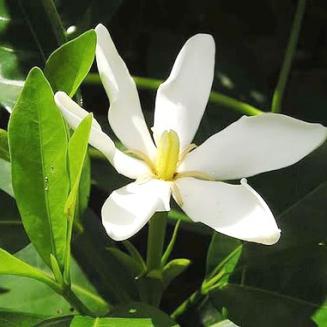
Code: CJ
|
:
|
English name: Cape jasmine.
Description: Small evergreen tree, 1-2 m. high. Leaves opposite or in whorl of 3, shining, glabrous on the upper side; stipule large, amplexicaul. Flowers yellowish-white, fragrant, solitary at the end of branchlets. Fruit ovoid, angular, tipped with remains of calyx, pulp yellowish-orange. Seeds numerous. The species Gardenia stenophyllus Merr. is also used medicinally.
Flowering period: March - May.
Distribution: Grows wild in wet places and is cultivated for ornament.
Parts used: leaves and fruit. The leaves can be harvested all the year round. After being well washed, they are dried in the sun or in dryers. The ripe fruit is picked from August to November.
Chemical composition: The leaves and fruit contain glucosides (gardenoside, gentiobioside, geniposide, crocin, gardenin); tannin; essential oil; pectin; b-sitosterol; D-mannitol; nonacosane.
Therapeutic uses: The leaves and fruit possess antibacterial, antifebrile, demulcent, cholagogic and diuretic properties. They are used in treating fever, jaundice, epistaxis, sore throat, haemoptysis, bloody stools, dysuria, bums, boils and impetigo.
The daily dose is 6 to 12 g of fruit in decoction, used on its own or in combination with Adenosma glutinosum. A poultice of pounded fresh leaves is effective for wounds, phlegmon and acute conjunctivitis.